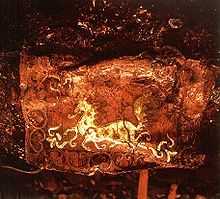Chollima
| Chollima | |||||||||||
|
Picture of Chollima | |||||||||||
| Chinese name | |||||||||||
|---|---|---|---|---|---|---|---|---|---|---|---|
| Traditional Chinese | 千里馬 | ||||||||||
| Simplified Chinese | 千里马 | ||||||||||
| Literal meaning | Thousand li horse | ||||||||||
| |||||||||||
| Korean name | |||||||||||
| Chosŏn'gŭl | 천리마 | ||||||||||
| Hancha | 千里馬 | ||||||||||
| |||||||||||
| Japanese name | |||||||||||
| Kanji | 千里馬 | ||||||||||
| Kana | センリマ | ||||||||||
| |||||||||||
A Chollima (also Qianlima or Senrima, literally "thousand-mile horse"), is a mythical winged horse which originates from the Chinese classics and is commonly portrayed in East Asian cultures. This winged horse is said to be too swift and elegant to be mounted (by any mortal man).
China
Beginning around the 3rd century BCE, Chinese classics mention Bole, a mythological horse-tamer, as an exemplar of horse judging. Bole is frequently associated with the fabled qianlima (Chinese: 千里馬) "thousand-miles horse", which was supposedly able to gallop one thousand li (approximately 400 km) in a single day (e.g., Red Hare). Qianlima was a literary Chinese word for people with latent talent and ability; and Spring (1988:180) suggests, "For centuries of Chinese history, horses had been considered animals capable of performing feats requiring exceptional strength and endurance.[1] Possibly it is for this reason that from early times horses have been used allegorically to represent extraordinary people." Bole recognizing a qianlima was a metaphor for a wise ruler selecting talented shi "scholar-officials". Thus, (Henry 1987:28) "Geniuses in obscurity were called thousand li horses who had not yet met their [Bole]".[2]
Japan
Keitoku Senrima (Kim Ge-Dok), a professional middleweight boxer in Japan, uses the stage name "Senrima" (the Japanese form of Qianlima/Chollima) to reference North Korea's Chollima campaigns and thereby express his Zainichi Korean heritage.[3]
North Korea
Chollima is an important symbol in North Korea. It is the nickname of the North Korean national football team. It gave its name to the Chollima Movement, which promoted fast economic development, similar to that of the Chinese Great Leap Forward and the Soviet Stakhanovite movement. After the Korean War, the country required rebuilding to function again. In order to expedite the construction, President Kim Il Sung devised the slogan “rush as the speed of Chollima.”
Several statues are found of this creature in Pyongyang, the capital of North Korea. The Chollima Statue symbolizes "heroism, the constant, fighting spirit of the Korean people, and the innovations and advance so quickly, at the speed of the Chollima". A notable one can be found on Mansu Hill, and was finished on April 15, 1961. It stands roughly 46 meters high and 16 meters long, measured from the pavement to the top of the Red Letter of the Central Committee of the Workers’ Party of Korea representing the working class.
See also
References
- "North Korea's Winged Horse 'Chollima Statue'" The People's Korea. 2008. Web. 9 Mar. 2012. <http://www.3833.com/node/1063>.
- "Info on Chollima Statue, Pyongyang, North Korea - Travel, Tourism, Hotels, Tours & Holidays." Info About North Korea. Web. 22 Mar. 2012. <http://www.northkorea1on1.com/attractions.cfm?aid=pyochollimastat>.
- ↑ Spring, Madeline K. (1988). "Fabulous Horses and Worthy Scholars in Ninth-Century China". T'oung Pao (74.4/5): 173–210.
- ↑ Henry, Eric (1987). "The Motif of Recognition in Early China". Harvard Journal of Asiatic Studies 47 (1): 5–30 [28]. doi:10.2307/2719156.
- ↑ Goodman, Lauren Seth (2006). Endless Punchers: Body, Narrative, and Performance in the World of Japanese Boxing. ProQuest. p. 442.
| ||||||||||||||||||||||||

